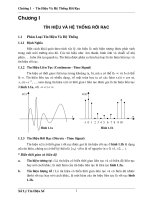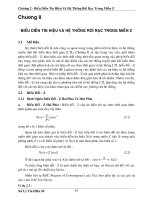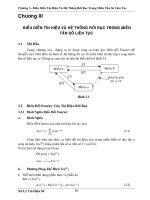xu ly tin hieu so1hoan chinh
Bạn đang xem bản rút gọn của tài liệu. Xem và tải ngay bản đầy đủ của tài liệu tại đây (1.01 MB, 24 trang )
LÊ THANH PHONG, MSSV:1080991
NGUYỄN PHAN NGỌC THANH KHIẾT, MSSV:1080857
ĐOÀN ÁI QUỐC, MSSV:1080935
Section: Nhóm chiều thứ 5.
Laboratory Exercise 1
DISCRETETIME SIGNALS: TIMEDOMAIN REPRESENTATION
1.1 GENERATION OF SEQUENCES
Project 1.1
Unit sample and unit step sequences
A copy of Program P1_1 is given below.
< Insert program code here. Copy from m-file(s) and paste. >
>> % Program P1_1
% Generation of a Unit Sample Sequence
clf;
% Generate a vector from -10 to 20
n = -10:20;
% Generate the unit sample sequence
u = [zeros(1,10) 1 zeros(1,20)];
% Plot the unit sample sequence
stem(n,u);
xlabel('Time index n');ylabel('Amplitude');
title('Unit Sample Sequence');
axis([-10 20 0 1.2]);
Answers:
Q1.1
The unit sample sequence u[n] generated by running
Program P1_1 is shown below:
< Insert MATLAB figure(s) here. Copy from figure window(s) and
paste. >
Unit Sample Sequence
1
Amplitude
0.8
0.6
0.4
0.2
0
10
Q1.2
5
0
5
Time index n
10
15
20
The purpose of clf command is xoá các giá trị được xử lý
trước đó
The purpose of axis command is –tạo trục toạ độ với các giá trị tương
ứng trong hàm AXIS([XMIN XMAX YMIN YMAX]
The purpose of title command is –tạo tiêu đề cho đồ thị
The purpose of xlabel command is –tạo nhãn cho trục x
The purpose of ylabel command is –tạo nhãn cho trục y
Q1.3 The modified Program P1_1 to generate a delayed unit
sample sequence ud[n] with a delay of 11 samples is given
below along with the sequence generated by running this
program.
< Insert program code here. Copy from m-file(s) and paste. >
% Program P1_1
% Generation of a Unit Sample Sequence
clf;
% Generate a vector from -10 to 20
n = -10:20;
% Generate the unit sample sequence
u = [zeros(1,21) 1 zeros(1,9)];
% Plot the unit sample sequence
stem(n,u);
xlabel('Time index n');ylabel('Amplitude');
title('Unit Sample Sequence');
axis([-10 20 0 1.2]);
< Insert MATLAB figure(s) here. Copy from figure
window(s)
and
paste.
>
Unit Sample Sequence
1
Amplitude
0.8
0.6
0.4
0.2
0
10
5
0
5
Time index n
10
15
20
Q1.4 The modified Program P1_1 to generate a unit step sequence
s[n] is given below along with the sequence generated by
running this program.
< Insert program code here. Copy from m-file(s) and paste. >
% Program P1_1
% Generation of a Unit Sample Sequence
clf;
% Generate a vector from -10 to 20
n = -10:20;
% Generate the unit sample sequence
u = [zeros(1,10) 1 ones(1,20)];
% Plot the unit sample sequence
stem(n,u);
xlabel('Time index n');ylabel('Amplitude');
title('Unit Sample Sequence');
axis([-10 20 0 1.2]);
< Insert MATLAB figure(s) here.
window(s) and paste. >
Copy from figure
Unit Sample Sequence
1
Amplitude
0.8
0.6
0.4
0.2
0
10
5
0
5
Time index n
10
15
Q1.5 The modified Program P1_1 to generate a unit step sequence
sd[n] with an advance of 7 samples is given below along
with the sequence generated by running this program.
20
< Insert program code here. Copy from m-file(s) and paste. >
% Program P1_1
% Generation of a Unit Sample Sequence
clf;
% Generate a vector from -10 to 20
n = -10:20;
% Generate the unit sample sequence
u = [zeros(1,3) 1 zeros(1,27)];
% Plot the unit sample sequence
stem(n,u);
xlabel('Time index n');ylabel('Amplitude');
title('Unit Sample Sequence');
axis([-10 20 0 1.2]);
< Insert MATLAB figure(s) here.
window(s) and paste. >
Copy from figure
Unit Sample Sequence
1
Amplitude
0.8
0.6
0.4
0.2
0
10
Project 1.2
5
Exponential signals
0
5
Time index n
10
15
20
A copy of Programs P1_2 and P1_3 are given below.
< Insert program code here. Copy from m-file(s) and paste. >
% Program P1_2
% Generation of a complex exponential sequence
clf;
c = -(1/12)+(pi/6)*i;
K = 2;
n = 0:40;
x = K*exp(c*n);
subplot(2,1,1);
stem(n,real(x));
xlabel('Time index n');ylabel('Amplitude');
title('Real part');
subplot(2,1,2);
stem(n,imag(x));
xlabel('Time index n');ylabel('Amplitude');
title('Imaginary part');
% Program P1_3
% Generation of a real exponential sequence
clf;
n = 0:35; a = 1.2; K = 0.2;
x = K*a.^n;
stem(n,x);
xlabel('Time index n');ylabel('Amplitude');
Answers:
Q1.6 The complex-valued exponential sequence generated by
running Program P1_2 is shown below:
< Insert MATLAB figure(s) here.
window(s) and paste. >
Copy from figure
Real part
Amplitude
2
1
0
1
2
0
5
10
15
20
25
Time index n
Imaginary part
30
35
40
0
5
10
15
20
25
Time index n
30
35
40
Amplitude
2
1
0
1
Q1.7 The parameter controlling the rate of growth or decay of this
sequence is – đồ thị tăng giảm về biên độ
The parameter controlling the amplitude of this sequence is – bán kỳ
thứ nhất biên độ dương, bán kỳ thứ hai biên độ âm và biên độ giảm dần theo
thời gian
Q1.8
The result of changing the parameter c to (1/12)+
(pi/6)*i is – gấp đồ thị
Q1.9
hiệu
The purpose of the operator real is – lấy phần thực của tín
The purpose of the operator imag is –lấy phần ảo của tín hiệu
Q1.10
The purpose of the command subplot is – lấy mẫu tín hiệu
Q1.11
The real-valued exponential sequence generated by
running Program P1_3 is shown below:
< Insert MATLAB figure(s) here.
window(s) and paste. >
Copy from figure
120
100
Amplitude
80
60
40
20
0
0
5
10
15
20
Time index n
25
30
Q1.12
The parameter controlling the rate of growth or decay of
this sequence is –biên độ
The parameter controlling the amplitude of this sequence is – biên
độ tăng dần theo thời gian
Q1.13
The difference between the arithmetic operators ^ and .^
is :
Toán tử .^ là lũy thừa từng phần tử tương ứng của ma trận
Toán tử ^ là lũy thừa ma trận
Q1.14
The sequence generated by running Program P1_3 with
the parameter a changed to 0.9 and the parameter K
changed to 20 is shown below:
< Insert MATLAB figure(s) here.
window(s) and paste. >
Copy from figure
35
20
18
16
14
12
10
8
6
4
2
0
0
5
10
15
20
25
30
Q1.15
The length of this sequence is – 36 mẫu
It is controlled by the following MATLAB command line: x =
K*a.^n;
It can be changed to generate sequences with different
lengths as follows (give an example command line and the
corresponding length):
n = 0:30; a = 1.2; K = 0.9;
x = K*a.^n;
stem(n,x);
Q1.16
The energies of the real-valued exponential sequences
x[n]generated in Q1.11 and Q1.14 and computed using the
command sum are –
Năng lượng:
E = X2[0]+…+X2[35]
E = 0.2(11.236)/(11.2) = 707.8J
35
E = 20(10.936)/(11.9) = 195.5J
Project 1.3
Sinusoidal sequences
A copy of Program P1_4 is given below.
< Insert program code here. Copy from m-file(s) and paste. >
% Program P1_4
% Generation of a sinusoidal sequence
n = 0:40;
f = 0.1;
phase = 0;
A = 1.5;
arg = 2*pi*f*n - phase;
x = A*cos(arg);
clf;
% Clear old graph
stem(n,x);
% Plot the generated sequence
axis([0 40 -2 2]);
grid;
title('Sinusoidal Sequence');
xlabel('Time index n');
ylabel('Amplitude');
axis;
Answers:
Q1.17
The sinusoidal sequence generated by running Program
P1_4 is displayed below.
< Insert MATLAB figure(s) here.
window(s) and paste. >
Copy from figure
Sinusoidal Sequence
2
1.5
1
Amplitude
0.5
0
0.5
1
1.5
2
Q1.18
0
5
10
15
20
25
Time index n
30
35
The frequency of this sequence is – 0.1 đơn vị thời gian
It is controlled by the following MATLAB command line:f = 0.1;
A sequence with new frequency ___0.05 đơn vị thời gian__ can be
generated by the following command line: f =0.05;
The parameter controlling the phase of this sequence is –Phase = 0
The parameter controlling the amplitude of this sequence is A
= 1.5;
The period of this sequence is
T = 1/f=10
Q1.19
The length of this sequence is – 41 mẫu
It is controlled by the following MATLAB command line: n =
0:40;
A sequence with new length ___20__ can be generated by the
following command line: n = 0:20;
Q1.20
The average power of the generated sinusoidal sequence
is : P = A2/2
40
Q1.21
The purpose of axis command is tạo trục toạ độ với các giá
trị tương ứng trong hàm AXIS([XMIN XMAX YMIN YMAX]
The purpose of grid command is ẩn hoặc hiện đường lưới trên đồ thị
Q1.22
The modified Program P1_4 to generate a sinusoidal
sequence of frequency 0.9 is given below along with the
sequence generated by running it.
< Insert program code here. Copy from m-file(s) and paste. >
% Program P1_4
% Generation of a sinusoidal sequence
n = 0:40;
f = 0.9;
phase = 0;
A = 1.5;
arg = 2*pi*f*n - phase;
x = A*cos(arg);
clf;
% Clear old graph
stem(n,x);
% Plot the generated sequence
axis([0 40 -2 2]);
grid;
title('Sinusoidal Sequence');
xlabel('Time index n');
ylabel('Amplitude');
axis;
< Insert MATLAB figure(s) here.
window(s) and paste. >
Copy from figure
Sinusoidal Sequence
2
1.5
1
Amplitude
0.5
0
0.5
1
1.5
2
0
5
10
15
20
25
Time index n
30
35
A comparison of this new sequence with the one generated in
Question Q1.17 shows giống nhau
A sinusoidal sequence of frequency 1.1 generated by modifying
Program P1_4 is shown below.
< Insert MATLAB figure(s) here.
window(s) and paste. >
Copy from figure
40
Sinusoidal Sequence
2
1.5
1
Amplitude
0.5
0
0.5
1
1.5
2
0
5
10
15
20
25
Time index n
30
35
A comparison of this new sequence with the one generated in
Question Q1.17 shows giống nhau
Q1.23
The sinusoidal sequence of length 50, frequency 0.08,
amplitude 2.5, and phase shift of 90 degrees generated by
modifying Program P1_4 is displayed below.
< Insert MATLAB figure(s) here.
window(s) and paste. >
Copy from figure
40
Sinusoidal Sequence
3
2
Amplitude
1
0
1
2
3
0
5
10
15
20
25
Time index n
30
35
The period of this sequence is – T = 1/f =1/0.08 = 1.25 đơn vị thời gian
Q1.24
By replacing the stem command in Program P1_4 with
the plot command, the plot obtained is as shown below:
< Insert MATLAB figure(s) here.
window(s) and paste. >
Copy from figure
40
Sinusoidal Sequence
2
1.5
1
Amplitude
0.5
0
0.5
1
1.5
2
0
5
10
15
20
25
Time index n
30
35
The difference between the new plot and the one generated in
Question Q1.17 is –ở câu Q1.17 tín hiệu là các mẫu rời rạc còn ở câu
Q1.24 thì tín hiệu là liên tục.
Q1.25
By replacing the stem command in Program P1_4 with the
stairs command the plot obtained is as shown below:
< Insert MATLAB figure(s) here.
window(s) and paste. >
Copy from figure
40
Sinusoidal Sequence
2
1.5
1
Amplitude
0.5
0
0.5
1
1.5
2
0
5
10
15
20
25
Time index n
30
35
The difference between the new plot and those generated in
Questions Q1.17 and Q1.24 is ở câu Q1.17 tín hiệu là các mẫu rời
rạc còn ở câu Q1.25 thì tín hiệu có dạng bậc thang.
Project 1.4
Random signals
Answers:
Q1.26
The MATLAB program to generate and display a random
signal of length 100 with elements uniformly distributed in
the interval [–2, 2] is given below along with the plot of the
random sequence generated by running the program:
< Insert program code here. Copy from m-file(s) and paste. >
% Program P1_4
clf;
n = 100;
d = 1.5*(rand(n,1)); % Generate random noise
m = 0:n-1;
plot(m,d');
40
axis([0 100 -2 2]);
xlabel('Time index n');ylabel('Amplitude');
grid;
< Insert MATLAB figure(s) here.
window(s) and paste. >
Copy from figure
2
1.5
1
Amplitude
0.5
0
0.5
1
1.5
2
0
10
20
30
40
50
60
Time index n
70
80
90
100
Q1.27
The MATLAB program to generate and display a Gaussian
random signal of length 75 with elements normally
distributed with zero mean and a variance of 3 is given
below along with the plot of the random sequence generated
by running the program:
< Insert program code here. Copy from m-file(s) and paste. >
< Insert MATLAB figure(s) here.
window(s) and paste. >
Copy from figure
Q1.28
The MATLAB program to generate and display five
sample sequences of a random sinusoidal signal of length 31
{X[n]} = {A>cos(on + )}
where the amplitude A and the phase are statistically independent
random variables with uniform probability distribution in the
0 A 4 for the amplitude and in the range 0
range
for the phase is given below. Also shown are five sample
sequences generated by running this program five different
times.
< Insert program code here. Copy from m-file(s) and paste. >
< Insert MATLAB figure(s) here.
window(s) and paste. >
Copy from figure
1.2 SIMPLE OPERATIONS ON SEQUENCES
Project 1.5
Signal Smoothing
A copy of Program P1_5 is given below.
< Insert program code here. Copy from m-file(s) and paste. >
% Program P1_5
% Signal Smoothing by Averaging
clf;
R = 51;
d = 0.8*(rand(R,1) - 0.5); % Generate random noise
m = 0:R-1;
s = 2*m.*(0.9.^m); % Generate uncorrupted signal
x = s + d'; % Generate noise corrupted signal
subplot(2,1,1);
plot(m,d','r-',m,s,'g--',m,x,'b-.');
xlabel('Time index n');ylabel('Amplitude');
legend('d[n] ','s[n] ','x[n] ');
x1 = [0 0 x];x2 = [0 x 0];x3 = [x 0 0];
y = (x1 + x2 + x3)/3;
subplot(2,1,2);
plot(m,y(2:R+1),'r-',m,s,'g--');
legend( 'y[n] ','s[n] ');
xlabel('Time index n');ylabel('Amplitude');
Answers:
Q1.29
The signals generated by running Program P1_5 are
displayed below:
< Insert MATLAB figure(s) here.
window(s) and paste. >
Copy from figure
Amplitude
10
d[n]
s[n]
x[n]
5
0
5
0
5
10
15
20
25
30
Time index n
35
40
45
50
8
y[n]
s[n]
Amplitude
6
4
2
0
0
Q1.30
5
10
15
20
25
30
Time index n
35
40
45
50
The uncorrupted signal s[n]is : tín hiệu chưa bị nhiễu
The additive noise d[n]is : tín hiệu nhiễu
Q1.31
The statement x = s + d CAN / CANNOT be used to
generate the noise corrupted signal because : không được vì tín
hiệu s và d là hai ma trận khác nhau nên không thể cộng lại được
Q1.32
The relations between the signals x1, x2, and x3, and the
signal x are : là một phần tử trong ma trận hàng x1x2x3.
Q1.33
The purpose of the legend command is hiển thị chú thích
trên biểu đồ.
Project 1.6
Generation of Complex Signals
A copy of Program P1_6 is given below.
< Insert program code here. Copy from m-file(s) and paste. >
Program P1_6
% Generation of amplitude modulated sequence
clf;
n = 0:100;
m = 0.4;fH = 0.1; fL = 0.01;
xH = sin(2*pi*fH*n);
xL = sin(2*pi*fL*n);
y = (1+m*xL).*xH;
stem(n,y);grid;
xlabel('Time index n');ylabel('Amplitude');
Answers:
Q1.34
The amplitude modulated signals y[n] generated by
running Program P1_6 for various values of the frequencies
of the carrier signal xH[n] and the modulating signal xL[n],
and various values of the modulation index m are shown
below:
< Insert MATLAB figure(s) here.
window(s) and paste. >
Copy from figure
1.5
1
Amplitude
0.5
0
0.5
1
1.5
Q1.35
0
10
20
30
40
50
60
Time index n
70
80
90
100
The difference between the arithmetic operators * and .*
is :
Toán tử * là nhân ma trận.
Toán tử .* là nhân từng phần tử tương ứng trong ma trận
A copy of Program P1_7 is given below.
< Insert program code here. Copy from m-file(s) and paste. >
% Program P1_7
% Generation of a swept frequency sinusoidal
sequence
n = 0:100;
a = pi/2/100
b = 0;
arg = a*n.*n + b*n;
x = cos(arg);
clf;
stem(n, x);
axis([0,100,-1.5,1.5]);
title('Swept-Frequency Sinusoidal Signal');
xlabel('Time index n');
ylabel('Amplitude');
grid; axis;
Answers:
Q1.36
The
swept-frequency
sinusoidal
sequence x[n]
generated by running Program P1_7 is displayed below.
< Insert MATLAB figure(s) here.
window(s) and paste. >
Copy from figure
SweptFrequency Sinusoidal Signal
1.5
1
Amplitude
0.5
0
0.5
1
1.5
0
10
20
30
40
50
60
Time index n
70
80
90
100
Q1.37
The minimum and maximum frequencies of this signal
are : fmin = 1/400s ,fmax = 1/4s
Q1.38
The Program 1_7 modified to generate a swept sinusoidal
signal with a minimum frequency of 0.1 and a maximum
frequency of 0.3 is given below:
< Insert program code here. Copy from m-file(s) and paste. >
% Program P1_7
% Generation of a swept frequency sinusoidal
sequence
n = 0:100;
a = pi/2/100;
b = 0.5;
arg = a*n.*n + b*n;
x = cos(arg);
clf;
stem(n, x);
axis([0,100,-1.5,1.5]);
title('Swept-Frequency Sinusoidal Signal');
xlabel('Time index n');
ylabel('Amplitude');
grid; axis;
1.3 WORKSPACE INFORMATION
Date:
28/10/2010
Signature:









